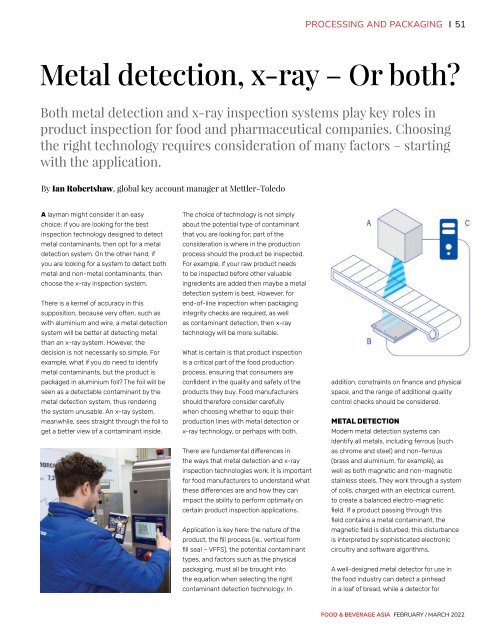Food & Beverage Asia February/March 2022
Food & Beverage Asia (FBA) is the leading source of food and beverage news in Asia since 2002. FBA delivers a comprehensive view of the food and beverage landscape, spanning across the latest health and nutrition trends and industry innovations in ingredients, recipe formulations, food science, sustainability, packaging, and automation, as well as advancements in agri and food-tech.
Food & Beverage Asia (FBA) is the leading source of food and beverage news in Asia since 2002. FBA delivers a comprehensive view of the food and beverage landscape, spanning across the latest health and nutrition trends and industry innovations in ingredients, recipe formulations, food science, sustainability, packaging, and automation, as well as advancements in agri and food-tech.
Create successful ePaper yourself
Turn your PDF publications into a flip-book with our unique Google optimized e-Paper software.
PROCESSING AND PACKAGING 51<br />
Metal detection, x-ray – Or both?<br />
Both metal detection and x-ray inspection systems play key roles in<br />
product inspection for food and pharmaceutical companies. Choosing<br />
the right technology requires consideration of many factors – starting<br />
with the application.<br />
By Ian Robertshaw, global key account manager at Mettler-Toledo<br />
A layman might consider it an easy<br />
choice: if you are looking for the best<br />
inspection technology designed to detect<br />
metal contaminants, then opt for a metal<br />
detection system. On the other hand, if<br />
you are looking for a system to detect both<br />
metal and non-metal contaminants, then<br />
choose the x-ray inspection system.<br />
There is a kernel of accuracy in this<br />
supposition, because very often, such as<br />
with aluminium and wire, a metal detection<br />
system will be better at detecting metal<br />
than an x-ray system. However, the<br />
decision is not necessarily so simple. For<br />
example, what if you do need to identify<br />
metal contaminants, but the product is<br />
packaged in aluminium foil? The foil will be<br />
seen as a detectable contaminant by the<br />
metal detection system, thus rendering<br />
the system unusable. An x-ray system,<br />
meanwhile, sees straight through the foil to<br />
get a better view of a contaminant inside.<br />
The choice of technology is not simply<br />
about the potential type of contaminant<br />
that you are looking for; part of the<br />
consideration is where in the production<br />
process should the product be inspected.<br />
For example, if your raw product needs<br />
to be inspected before other valuable<br />
ingredients are added then maybe a metal<br />
detection system is best. However, for<br />
end-of-line inspection when packaging<br />
integrity checks are required, as well<br />
as contaminant detection, then x-ray<br />
technology will be more suitable.<br />
What is certain is that product inspection<br />
is a critical part of the food production<br />
process, ensuring that consumers are<br />
confident in the quality and safety of the<br />
products they buy. <strong>Food</strong> manufacturers<br />
should therefore consider carefully<br />
when choosing whether to equip their<br />
production lines with metal detection or<br />
x-ray technology, or perhaps with both.<br />
There are fundamental differences in<br />
the ways that metal detection and x-ray<br />
inspection technologies work. It is important<br />
for food manufacturers to understand what<br />
these differences are and how they can<br />
impact the ability to perform optimally on<br />
certain product inspection applications.<br />
Application is key here: the nature of the<br />
product, the fill process (ie., vertical form<br />
fill seal – VFFS), the potential contaminant<br />
types, and factors such as the physical<br />
packaging, must all be brought into<br />
the equation when selecting the right<br />
contaminant detection technology. In<br />
addition, constraints on finance and physical<br />
space, and the range of additional quality<br />
control checks should be considered.<br />
METAL DETECTION<br />
Modern metal detection systems can<br />
identify all metals, including ferrous (such<br />
as chrome and steel) and non-ferrous<br />
(brass and aluminium, for example), as<br />
well as both magnetic and non-magnetic<br />
stainless steels. They work through a system<br />
of coils, charged with an electrical current,<br />
to create a balanced electro-magnetic<br />
field. If a product passing through this<br />
field contains a metal contaminant, the<br />
magnetic field is disturbed; this disturbance<br />
is interpreted by sophisticated electronic<br />
circuitry and software algorithms.<br />
A well-designed metal detector for use in<br />
the food industry can detect a pinhead<br />
in a loaf of bread, while a detector for<br />
FOOD & BEVERAGE ASIA FEBRUARY / MARCH <strong>2022</strong>


















